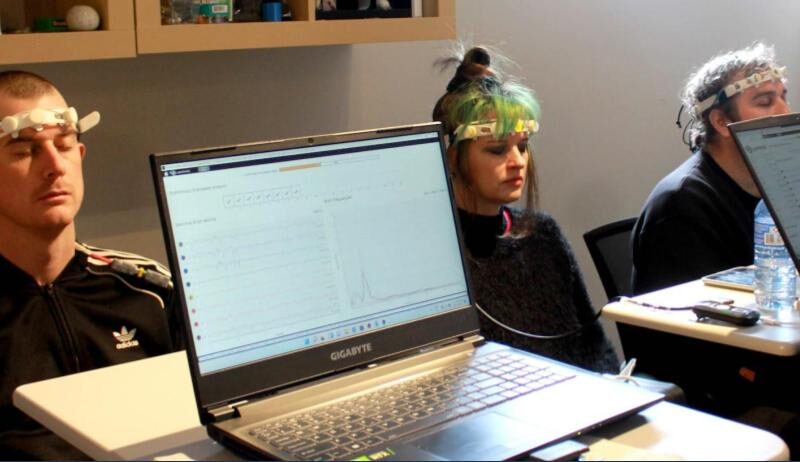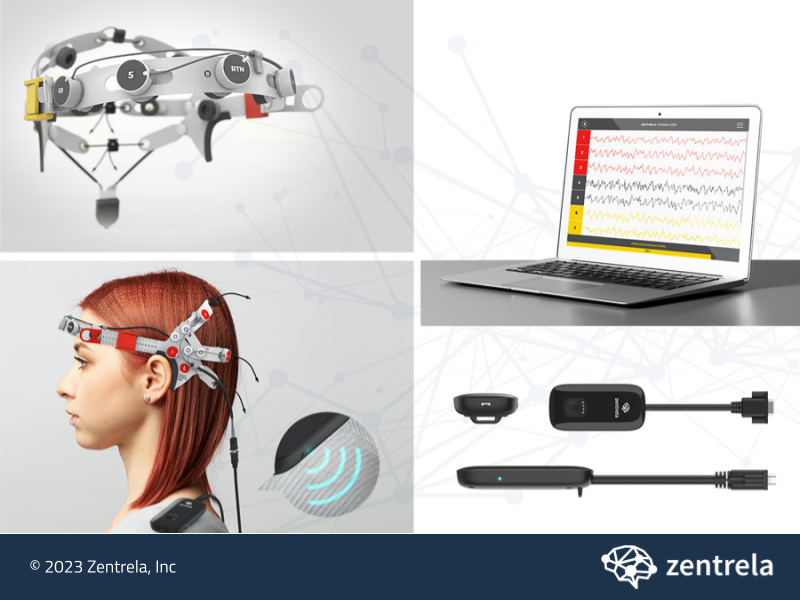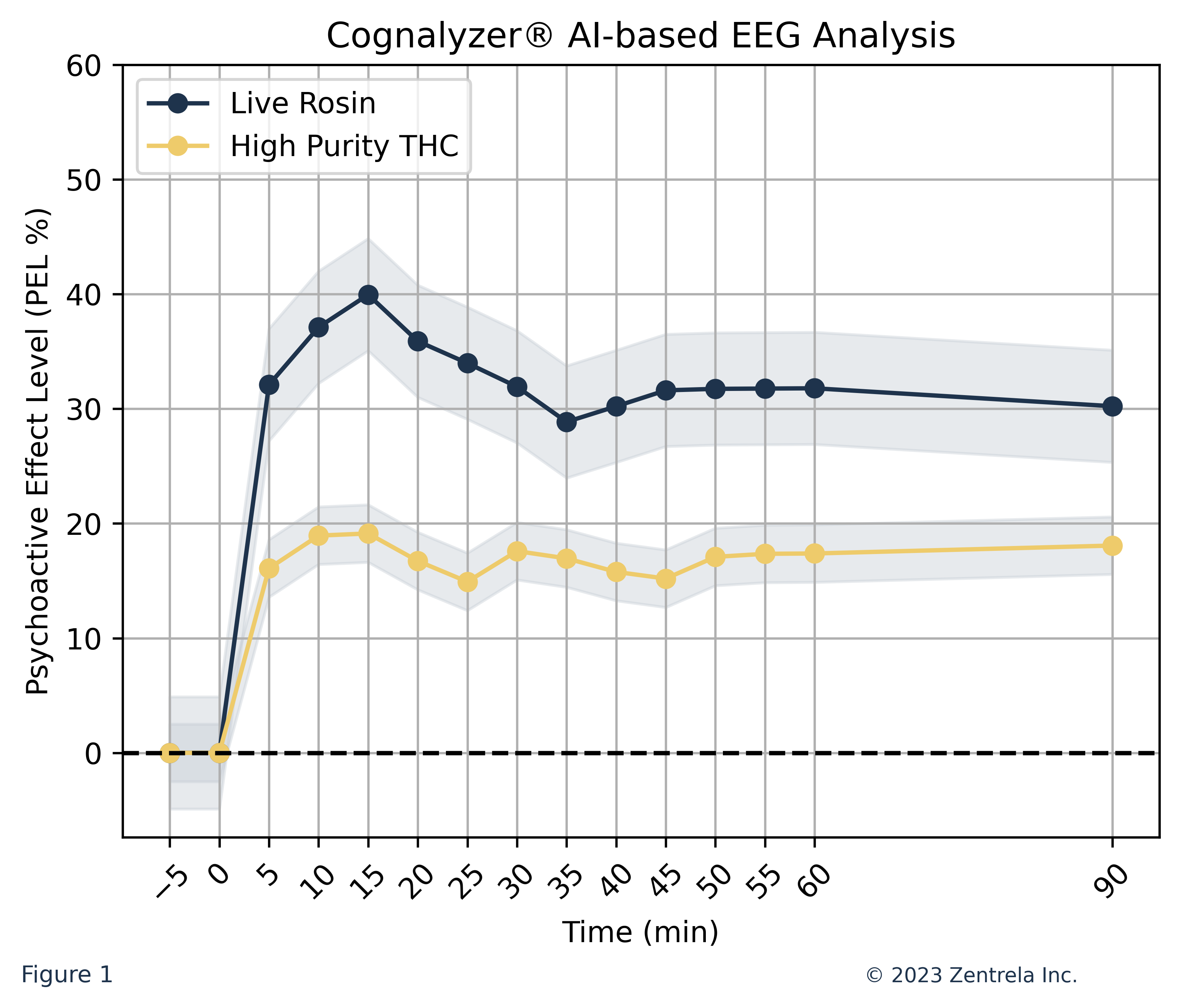Introduction
Introduction
The cannabis industry suffers from a lack of objective, scientific product effect information.
This is due to a combination of factors, including a difficult regulatory environment, the lack of objective scientific research tools for characterizing cannabis effects and a cost-time effective framework for conducting human trials. This lack of objective research data affects the entire industry. Producers are challenged to evaluate the efficacy of new products and formulations, retailers do not have the data they need to educate consumers or differentiate products.
On the other hand, consumers lack the information they need to make informed purchase and consumption decisions. The consequence of this information void is the proliferation of misleading paradigms surrounding cannabis products and their potential effects. One of these misconceptions is the widely held belief that the percentage of delta-9-tetrahydrocannabinol (THC %) is the most important factor for choosing products that will induce a strong psychoactive experience, commonly referred to as the “HIGH”. However, it is well-established that products with comparable THC potency can produce significantly different psychoactive effects, depending on how they are formulated.
PAX Labs is a global leader in the use of science to develop and commercialize vaporizers and cannabis products in multiple formats, including cartridges. Their continuous investment in product innovation has resulted in remarkable advancements, including the methodology employed in extracting cannabis compounds for the development of vape cartridges.
Zentrela partnered with PAX Labs to study the unique effects created by two different types of PAX cannabis oils: Live Rosin with Natural Diamonds, made from cold-pressed flower to preserve the natural cannabinoids, terpenes and other plant compounds, and High Purity THC, a cannabis oil enhanced with terpene blends.
Central to this research initiative, Zentrela equipped PAX Labs with portable non-invasive EEG (electroencephalography) technology, facilitating the collection of raw EEG data, commonly referred to as brainwave data, as described in the Methodology section of this paper. Zentrela utilized proprietary Machine Learning algorithms to objectively analyze the EEG of the study subjects, detecting EEG alterations associated with the consumption of cannabis and quantifying the strength of the psychoactive effects. This is described in the “Cognalyzer® AI-based EEG Analysis” section of this paper.
This research paper discusses the notable variations in onset time and strength of the psychoactive effect differences between these two types of PAX cannabis oil products.
Methodology
Methodology
This study was conducted with 28 study subjects.
Fourteen participants inhaled 2 hits (8mg) of vapor from the Blue Dream Live Rosin cannabis oil (average 85% THC potency, 90% TAC potency) using the PAX Era Pro (Study Group 1) and the other 14 participants inhaled 2 hits (8mg) of vapor from the Berry Gelato High Purity THC cannabis oil (average 82-85% THC potency, 87-90% TAC potency) also using the PAX Era Pro (Study Group 2).
Zentrela’s non-invasive portable EEG device and desktop application were used to record study subject’s EEG data from 8 different regions of the brain (right and left sides of the frontal, temporal, parietal and occipital lobes).
The standardized process of collecting raw EEG data, (called “EEG Test ”) consists of around 2-minute-long recordings depending on the quality and integrity of the EEG data that is being recorded. Internal and external noise is ignored.
Two EEG Tests were administered before product consumption to calibrate the Cognalyzer® AI solution (read more about the Cognalyzer® AI-based EEG analytics in the next section) and 9 more EEG Tests were administered 5, 10, 15, 20, 25, 30, 45, and 90 minutes after product consumption. Cognalyzer® EEG (brainwave) analysis was used to convert EEG Tests into psychoactive effect levels (PEL) in a standardized scale from 0% to 100%. Learn more about it in the following section.
The cubic spline interpolation method was used to accurately characterize PELs minute by minute post product consumption and per participant / visit. Then, the PELs of each group of study subjects were aggregated. Statistical analysis was conducted to determine the higher and lower bounds of the aggregated PELs of each study group using >90% confidence intervals.
The onset time of the THC psychoactive effect for each study group was determined by aggregating their PELs, and then calculating the time point at which the lower bound of the 90% confidence interval reached or exceeded a PEL of 10%.
The maximum potency per group was determined by finding the maximum PEL of each curve and its time point.
Cognalyzer® AI-based EEG Analysis
Cognalyzer® AI-based EEG Analysis
After 5 years (2016-2021) of full R&D laser-focused efforts, the neurotechnology company Zentrela, Inc. which is led by Israel Gasperin (an engineer, entrepreneur, and founder of Zentrela), and Dr. Dan Bosnyak (a McMaster neuroscientist, Director of the neuroscience McMaster LIVELab, and CSO of Zentrela), developed an EEG-based method, called Cognalyzer®, for detecting the effects cannabis products have on the brain in an objective and standardized manner.
Its novelty and unprecedented accuracy relies on using Machine Learning in large EEG datasets accurately recorded under rigorous scientific protocols to do complex EEG analysis that we humans are not able to do in order to find complex but specific EEG features (brainwave changes) directly associated with the effects substances like THC have on the brain.
The second novelty of Zentrela’s solution is a standardized method for recording EEG data (called “EEG Test”) and quantifying the presence of a substance’s effect. The drug effect quantification method consists of recording ~2 mins of EEG data from 8 different regions of the brain (right and left sides of the frontal, temporal, parietal and occipital lobes) using Zentrela’s proprietary EEG headset and then calculating the amount of time (within the ~2-min recording ) that a subject is experiencing EEG alterations. This is calculated by the number of EEG segments that are classified by Zentrela’s scientifically validated AI as “altered” by the THC effect (called “PEL”).
The accuracy and objectivity of the Cognalyzer® measurement of cannabis psychoactive effects has been independently validated by the clinical research organization KGK Science, Inc., and the following peer-reviewed publications:
https://link.springer.com/article/10.1007/s12325-021-01718-6
https://link.springer.com/article/10.1007/s40120-021-00293-w
Study Results
Study Results
The time evolution of the psychoactive effect of the two study groups are shown in Figure 1.
The first study group, which inhaled 2 hits of the Blue Dream Live Rosin PAX Era pod, experienced an onset time of 3 minutes, while the second group who also inhaled 2 hits, but from the Berry Gelato High Purity THC PAX Era pod, had an onset time of 4 minutes.
With regard to the maximum strength of the psychoactive experience of each product, the first study group reached a 39% PEL based on the Cognalyzer® brainwave scale at minute 15 post product inhalation. The maximum PEL of the second study group was 19% PEL and it also happened at minute 15 post product intake. The difference in the highest point of the PEL among the two study groups at the 15-minute mark is 20%. Statistical analysis was conducted to validate with 90% level of confidence this notably distinct potency between the two study groups.
Table 1 – Study results
Product Names | Consumption Time | Onset Time | Potency at Onset (%) | Peak Time | Potency at Peak (%) | Potency at 90 Minutes (%) |
Live Rosin (Blue Dream) | < 1 min | 3 min | 20.8 (15.9 – 25.7) | 15 min | 40.0 (35.1 – 44.8) | 30.2 (25.3 – 35.1) |
High Purity THC (Berry Gelato) | < 1 min | 4 min | 13.5 (11.0 – 16.0) | 15 min | 19.1 (16.6 – 21.6) | 18.1 (15.6 – 20.6) |
Table 2 – Statistical analysis
At Onset time: 3 min | At Onset time: 4 min | At Peak Time: 15 min | At 90 Minutes | |
Difference | 10.46 | 13.61 | 20.83 | 3.83 |
90% Confidence Interval | -0.52 to 21.43 | -0.35 to 27.56 | 2.63 to 39.02 | -13.11 to 20.77 |
Reliability | Trend | Trend | Confirmed | Not Significant |
Research Framework
Research Framework
Research Framework
| Research Organization: | Zentrela Inc. |
|---|---|
Scientific Research Model: | Non-therapeutic cannabis effect research |
Consumer Attestation: | Fully informed consent form (ICF) |
Principal Investigators: | Dr. Bosnyak, Dr. Rufer |
Authors: | Upmanyu Sharma, Israel Gasperin Haaz, Dr. Dan Bosnyak, Dr. David Faulkner, Ricardo Zelidon, Dr. Echo Rufer. |
Study Size: | 28 study subjects |
Research Tools: | Cognalyzer® AI-driven EEG analytics. |
Research Facility Location: | PAX Labs 660 Alabama St, San Francisco, CA |
Conclusion
In conclusion, the objective brainwave analysis conducted in this study reveals noteworthy distinctions in the psychoactive experience between the study groups that inhaled the Live Rosin PAX Era pod and the High Purity THC PAX Era pod. The first group exhibited a considerably faster and more potent psychoactive response compared to the latter group. A key contributor to these disparate outcomes may be attributed to the different compounds present in the Live Rosin versus the High Purity THC PAX Era pods. Notably, the Live Rosin extraction method preserves not only THC but an array of other terpene compounds inherent to cannabis flowers. It is possible that the intricate interplay of these compounds contributes to the heightened psychoactive effect witnessed with Live Rosin PAX Era pods, and suggests that THC alone is not the sole contributor to potency. Evidenced by the more mellow THC psychoactive experience associated with Berry Gelato High Purity THC PAX Era pod, in contrast to the Blue Dream Live Rosin PAX Era pod, more than 2 consecutive hits may significantly amplify the potency and accelerate the onset time of the THC psychoactive response.
Future brainwave studies are envisioned to validate and consolidate these findings. Moreover, these studies will strive to quantify the onset time and potency characteristics of Diamond Pods, enhancing comprehension of the nuanced distinctions among PAX’s primary cartridge offerings. This endeavor not only deepens our comprehension of consumer experiences but also underscores the commitment to providing accurate and comprehensive information to consumers, thereby fostering informed product selection and consumption decisions.
Copyright, Disclaimers and Terms of Use
Copyright © 2023 Zentrela Inc. All rights reserved.
PAX, X, and ERA are all trademarks of PAX Labs, Inc. Patents and Trademarks: pax.com/IP
This website, source code, databases, functionality, software, website designs, audio, video, text, photographs, graphics, and data on the website and the relevant Zentrela trademarks, service marks, and logos contained therein (the “Material”) are owned or controlled by or licensed to Zentrela Inc. a corporation having its principal place of business at 231 Main St. W., Hamilton, Ontario, L8P 1J4, Canada (“Zentrela”).
The Material is protected by copyright and trademarks laws and other various other intellectual property rights and unfair competition laws of Canada, the United States, foreign jurisdictions and international conventions. All other trade names, trademarks, service marks and other product or service names and logos on or in the Material are the proprietary trademarks of their respective owners and are protected by applicable trademark and copyright laws.
Use of this website is subject to Terms of Use.



